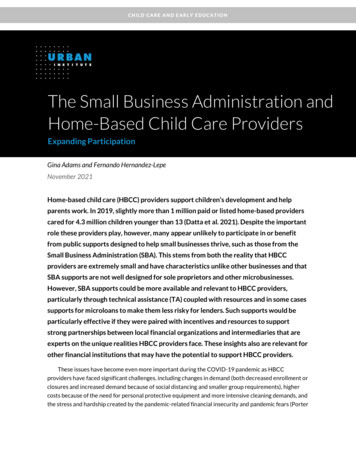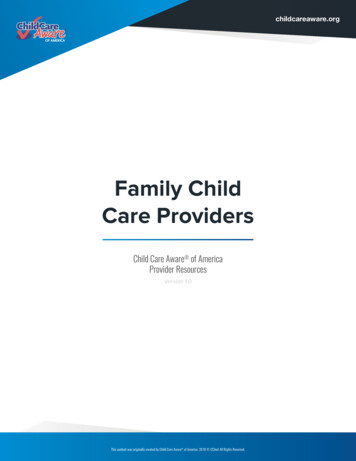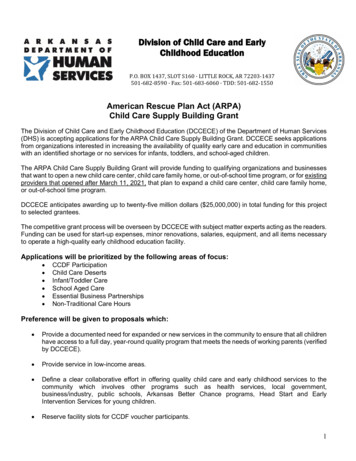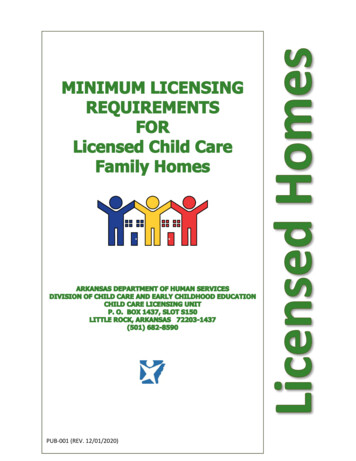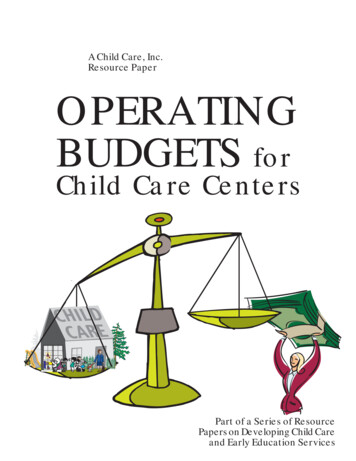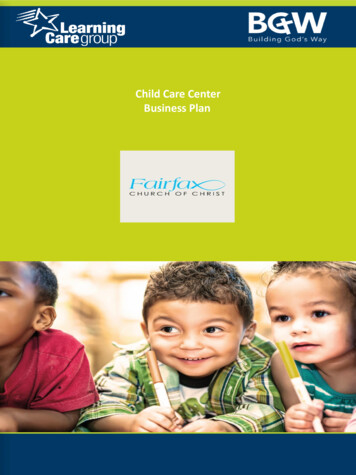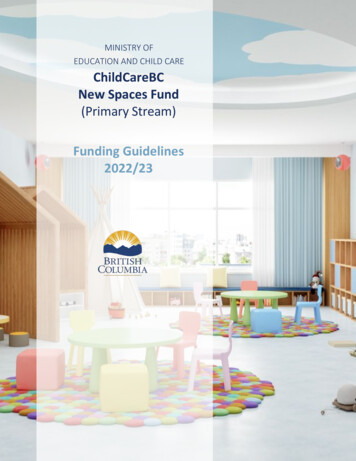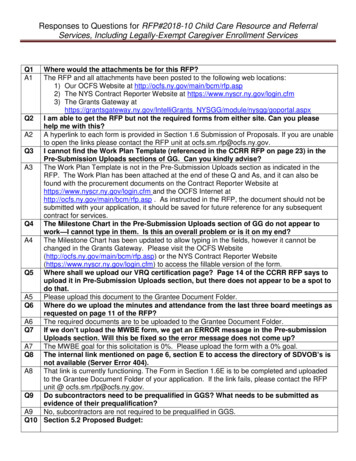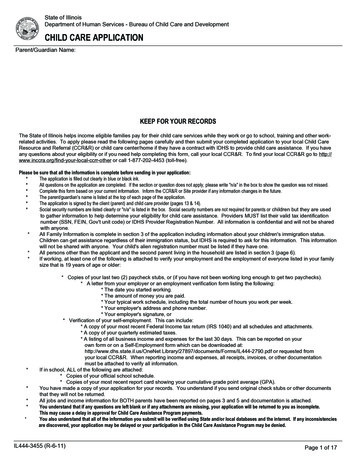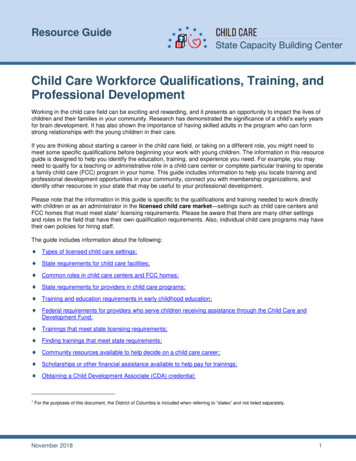
Transcription
Resource GuideChild Care Workforce Qualifications, Training, andProfessional DevelopmentWorking in the child care field can be exciting and rewarding, and it presents an opportunity to impact the lives ofchildren and their families in your community. Research has demonstrated the significance of a child’s early yearsfor brain development. It has also shown the importance of having skilled adults in the program who can formstrong relationships with the young children in their care.If you are thinking about starting a career in the child care field, or taking on a different role, you might need tomeet some specific qualifications before beginning your work with young children. The information in this resourceguide is designed to help you identify the education, training, and experience you need. For example, you mayneed to qualify for a teaching or administrative role in a child care center or complete particular training to operatea family child care (FCC) program in your home. This guide includes information to help you locate training andprofessional development opportunities in your community, connect you with membership organizations, andidentify other resources in your state that may be useful to your professional development.Please note that the information in this guide is specific to the qualifications and training needed to work directlywith children or as an administrator in the licensed child care market—settings such as child care centers andFCC homes that must meet state1 licensing requirements. Please be aware that there are many other settingsand roles in the field that have their own qualification requirements. Also, individual child care programs may havetheir own policies for hiring staff.The guide includes information about the following: Types of licensed child care settings; State requirements for child care facilities; Common roles in child care centers and FCC homes; State requirements for providers in child care programs; Training and education requirements in early childhood education; Federal requirements for providers who serve children receiving assistance through the Child Care andDevelopment Fund; Trainings that meet state licensing requirements; Finding trainings that meet state requirements; Community resources available to help decide on a child care career; Scholarships or other financial assistance available to help pay for trainings;U Obtaining a Child Development Associate (CDA) credential;T1For the purposes of this document, the District of Columbia is included when referring to “states” and not listed separately.November 20181
Child Care Workforce Early care and education membership organizations and professional associations; andT Additional resources about careers in child care.TThe State Capacity Building Center does not endorse any non-Federal organization, publication, or resource.Types of Licensed Child Care SettingsBackThere are two common types of child care settings that are part of the licensed child care market—child carecenters and family child care (FCC) homes.Child care centers are facilities where care typically is provided to children in a nonresidential building withdifferent age group classrooms. Care is provided for less than 24 hours per day. State child care licensingregulations include definitions of the types of child care centers that must meet licensing requirements. Thesedefinitions often include a minimum number of children served or a minimum number of hours the facility operatesto determine whether it must be licensed.FCC homes are facilities where care typically is provided to children in the provider’s residence. A FCC homeusually offers care to a small group of children of mixed ages and has one care provider. As with centers, stateshave definitions of the types of FCC homes that must be licensed. These definitions are usually based on thenumber of children in care. For example, several states require FCC homes to be licensed if the provider cares forat least one unrelated child or the children from one family, but many states also allow homes with three or morechildren to operate without a license. Many states license two types of FCC homes—a small home that has asmall number of children and usually one care provider, and a large or group home that usually has a largernumber of children and a provider and assistant.The types of child care settings that are required to be licensed can be very different from state to state. You canfind out about your state’s requirements by contacting the state child care licensing agency. The NationalDatabase of Child Care Licensing Regulations contains direct website links to state child care licensingregulation documents and licensing agency contact information. Users can access, download, and search statechild care licensing regulations that apply to child care centers, family child care homes, and other licensed childcare programs. The National Database of Child Care Licensing Regulations is available athttps://childcareta.acf.hhs.gov/licensing.State Requirements for Child Care FacilitiesBackLicensing is a process administered by state governments that gives permission to child care facilities to operate.Licensing sets a baseline of requirements below which it is illegal to operate,unless the facility is legally exempt from licensing. States have regulations thatinclude the requirements child care centers and family child care (FCC) homesmust comply with and policies to support the enforcement of those regulations.These regulations and enforcement policies vary widely from state to state.Some states may call this regulatory process “certification” or “registration.” Forthe purposes of this guide, the terms “licensing” or “licensed” are used torepresent all of the state regulatory processes.State child care licensing regulations help protect the health and safety ofchildren in out-of-home care. Licensing helps prevent different forms of harm to children, including risks from thespread of disease, fire, and other building safety hazards, and injury. Licensing also helps prevent developmentalimpairment from children’s lack of healthy relationships with adults, and regulates adequate supervision anddevelopmentally appropriate activities.November 20182
Child Care WorkforceThe National Database of Child Care Licensing Regulations contains direct website links to state child carelicensing regulation documents and licensing agency contact information. Users can access, download, andsearch state child care licensing regulations that apply to child care centers, family child care homes, and otherlicensed child care programs. The National Database of Child Care Licensing Regulations is available athttps://childcareta.acf.hhs.gov/licensing.Role Names in State RegulationsStates vary in the names they use for the teacher role in child care licensing regulations. Thefollowing are some of the names states use: Assistant group supervisor; Group teacher; Assistant to head of group; Lead caregiver; Associate teacher; Primary caregiver; Caregiver; Program leader; Caretaker; Senior staff; Child care supervisor; Staff; Child care worker; Teacher; and Group leader; Teacher assistant.Within the licensing regulations for centers and FCC homes are requirements for the people who work there. Asexplained further in this guide, these requirements include specific qualifications, such as being a certain age,completing training or education prior to working in a facility, completing training after being hired, meetingspecific health requirements, and passing background checks, among other things.Common Roles in Centers and FCC HomesBackThere are several different roles you can fulfill if you are working in a child care setting. These are the mostcommon:Child Care Center Roles Aide;Assistant teacher;Director;Family Child Care (FCC) Home Roles Small FCC home provider; FCC assistant; and Large or group FCC home provider.Master teacher; andTeacher.November 20183
Child Care WorkforceThe most common staff role for child care centers is teacher, which can be defined as a staff person who canbe solely responsible for a group of children. States may use other names for this role, such as caregiver, childcare worker, or group leader.Role Names in State RegulationsStates vary in the names they use for the master teacher role in child care licensing regulations.The following are some of the names states use: Assistant director; Head teacher; Child care associate; Lead caregiver; Fully qualified teacher; Lead teacher; Group supervisor; Master teacher; and Head of group Teacher.Some states require at least one teacher in a program or classroom to be qualified at a higher level. This positionis often called a lead teacher, head teacher, chief caregiver, fully qualified teacher, child care associate, orsupervisor. This role is generically labeled master teacher in this guide to reflect that this person is required tohave more training, experience, or skills than other teachers.Many states also have requirements for assistant teachers and aides who work with children in child carecenters under the supervision of an individual who is qualified as a teacher or master teacher.A director of a child care center is the administrator who is ultimately responsible for establishing the program,choosing and supervising all other staff, managing both income and expenditures, and maintaining programquality.If you wish to operate a child care program in your home, typically called FCC home, your role would be a FCCprovider. Some states have more than one type of FCC home. A small FCC home is a child care programlocated in a residence, generally with one provider and a small number of children. A large or group FCC homeis also typically located in a residence, but usually has one provider and an assistant and a larger number ofchildren. States vary in how they name these types of child care facilities and in how they define which settingsmust be licensed.State Requirements for Providers in Child Care Programs BackTo find out the requirements for child care center staff and family child care (FCC) home providers in your state,you can contact the state child care licensing agency. The National Database of Child Care LicensingRegulations contains direct website links to state child care licensing regulation documents and licensing agencycontact information. Users can access, download, and search state child care licensing regulations that apply tochild care centers, family child care homes, and other licensed child care programs. The National Database ofChild Care Licensing Regulations is available at https://childcareta.acf.hhs.gov/licensing.The following are explanations of the different types of licensing requirements you might have to meet to work in achild care center or FCC home.November 20184
Child Care WorkforceMinimum Age RequirementsMost states require child care center staff and FCC providers to be a certainage to work in or operate a program legally. The child care licensing regulationswill include this age. For example, most states require child care centerdirectors to be at least 21 years old, teachers to be at least 18 years old, andassistant teachers and aides to be at least 16 years old.High School Diploma or EquivalentMany states require center staff and FCC providers to have a high school diploma or equivalent, such as passingthe General Education Development Test (GED), prior to working in or operating a program. This is especiallytrue in states where the minimum age requirement for a particular role is 18 years old.Training and Education Requirements in Early ChildhoodEducationBackMany states require providers to have preservice qualifications—training or education in early care andeducation topics completed prior to working in, operating, or assuming a new role in a licensed child careprogram. The amount of training or education required varies widely from state to state. The National Center onEarly Childhood Quality Assurance (ECQA Center) maintains information about minimum training or educationrequired by state licensing agencies to qualify for center director, teacher, master teacher, and FCC providerroles. This information can be found in the document entitled CCDF Health and Safety Requirements Brief #9,which is available at s/public/healthsafety training brief.pdf.Most state child care licensing regulations include many options to qualify for roles. State licensing agencies haveprocedures they use to evaluate the qualifications of providers seeking to work in child care centers or operatefamily child care (FCC) homes.Work ExperienceIn addition to preservice qualifications for training and education, many states require that center staff and FCCproviders come to their roles with some experience working with children. Some states require experience as theonly qualification for a particular role, while others combine experience with education and training in theirqualifications. State child care licensing regulations typically specify the amount of experience required. Theymight specify that prospective providers must verify that their experience was in a particular setting, was with acertain age group of children, and was supervised.OrientationMany states require new employees, especially in child care centers, to complete an orientation training thatincludes information about the facility’s policies and procedures. This orientation is often given by the director ofthe center or the operator of the FCC home. State licensing regulations often specify the content of this training.States also require center staff and FCC home providers to complete training about the licensing process andregulations.November 20185
Child Care WorkforceOngoing Training HoursMost states require child care center staff and FCC providers to complete a specific number of hours of trainingeach year. The content of this training is generally related to the care and education of young children. It iscompleted through a variety of methods, such as adult education courses, college courses, conferenceworkshops, distance learning, and in-service training provided by the center director or FCC home operator. Childcare licensing regulations include the specific number of hours of required training and any requirements fortraining content.Health and Safety TrainingIn addition to the annual ongoing training hours, most states require child care staff to complete training in first aidand cardiopulmonary resuscitation (CPR). Many states also require training in other health and safety topics, suchas the following: Administration of medication; Care of sick children; Child abuse and neglect prevention and reporting; Fire safety; Hand washing; Prevention of HIV/AIDS and blood-borne pathogens; Prevention of the spread of communicable diseases (universal precautions); Reducing the risk of Sudden Infant Death Syndrome (SIDS); and Water safety or lifeguard training.Health RequirementsMost states require child care center staff and FCC providers to show proof that they are physically fit to care forchildren. To show they are in good health, staff and providers may need to provide the licensing agency withstatements from physicians, reports of physical examinations, or proof of immunizations and tuberculosis tests.Background ChecksMany states require that people who work in child care centers and FCC homes have not committed a crime orbeen accused of abuse or neglect of children in their care. States often require staff and providers to undergo atleast one type of criminal background check, either a check of criminal history records (which may be done withfingerprints), child abuse and neglect registries, or sex offender registries.Federal Requirements for Providers Serving ChildrenReceiving Assistance through CCDFBackThe Child Care and Development Block Grant Act 2014 requires that all states establish health and safety trainingrequirements in 10 different topic areas for child care providers serving children receiving assistance through theChild Care and Development Fund (CCDF) program.The topic areas in which you will need to get training are as follows:November 20186
Child Care Workforce1. Prevention and control of infectious diseases (including immunization);2. Reducing the risk of Sudden Infant Death Syndrome and safe sleeping practices;3. Medication administration;4. Preventing food and allergic reactions;5. Building and physical premises safety;6. Preventing and reporting Shaken baby Syndrome and abusive head trauma;7. Emergency preparedness and response planning;8. Handling and storage of hazardous materials;9. Transportation safety, if applicable; and10. First aid and cardiopulmonary resuscitation (CPR).Complete requirements and text of the law are on the Office of Head Start’s Early Childhood Learning &Knowledge Center site at .Your state may include a requirement for training about nutrition, access to physical activity, or other subjectareas the state determines is needed to promote child development or to protect children's health and safety.NOTE: To verify which training options your state will accept to meet this requirement, please contactyour state’s child care professional development lead. Contact information is available on the Office ofChild Care’s website at -profiles.TrainingThe following is a list of trainings that may help you meet the health and safetytraining requirements:Better Kid Care, an initiative of Pennsylvania State dcare/early-care/ccdbgVirtual Lab School, a program created by experts at Ohio State atch Me! Celebrating Milestones and Sharing Concerns, an online trainingcourse from the Center for Disease Control and Prevention dex.htmlFor more information, please see Early Educator Central; k .NOTE: To verify which training options your state will accept to meet this requirement, please contactyour state’s child care professional development lead. Contact information is available on the Office ofChild Care’s website at -profiles.Finding Trainings That Meet the State Requirements BackLocal child care resource and referral (CCR&R) agencies can provide information about training opportunities,professional development initiatives, and other resources in your area. Child Care Aware offers a Child CareFinder tool that provides contact information for all state and local CCR&R agencies r 20187
Child Care WorkforceIn addition, many states have systems that provide information about training and other resources to help peoplewho work in the early care and education field grow professionally. Many of these systems have a trainingcalendar or database of trainers or training sessions.Resources to help support you as a teacher or family child care provider are also provided at Early EducatorCentral, an online initiative that focuses on the careers of infant/toddler educators, seeking to advance theireducation and improve their competencies. It offers basic training and courses to assist in the pathway to acredential or degree. For more information, visit families-childcare-providers.Trainings That Meet State Licensing RequirementsBackState licensing agencies have ways to evaluate the qualifications of staff in child care centers and family childcare homes. You can contact the licensing agency in your state to find out whether the training that you havecompleted or plan to complete will meet state requirements. The National Database of Child Care LicensingRegulations contains direct website links to state child care licensing regulation documents and licensing agencycontact information. Users can access, download, and search state child care licensing regulations that apply tochild care centers, family child care homes, and other licensed child care programs. The National Database ofChild Care Licensing Regulations is available at y Resources to Help Decide on a Child Care CareerBackMany states have a professional development system that provides information, support, and other resourcesto help people who work, or may want to work, in the early care and education field. These state systems varywidely in the services and resources they offer. Your state’s professional development system may include someof the following resources: Career counseling and other professional development planning tools; A registry to track the training that you have obtained; A training calendar or database of state-approved trainers and training sessions; Core knowledge or competency documents that define what providers need to know, understand, and be ableto do to work effectively with young children; and A career lattice or ladder that defines pathways to help you better understand the variety of roles,responsibilities, and requirements within the early care and education field in your state.Scholarships or Other Financial Assistance Available to HelpPay for TrainingsBackScholarship ResourcesLocal child care resource and referral (CCR&R) agencies support child care providers with training and technicalassistance to help improve the quality of child care, and they may have information about scholarships. ChildCare Aware offers a Child Care Finder tool that provides contact information for all state and local CCR&Ragencies at http://childcareaware.org/resources/map/.November 20188
Child Care Workforce Quick Look: Scholarship Initiatives (2013), by the National Center on Child Care Professional DevelopmentSystems and Workforce Initiatives, is a document that provides an overview of state scholarship default/files/public/20130613 pdwcenter quicklook scholarships.pdfNovember 20189
Child Care WorkforceT.E.A.C.H. Early Childhood Project ScholarshipsPPChild Care Services AssociationPhone: 919-967-3272Website: https://www.childcareservices.org/teach-nc/The T.E.A.C.H. [Teacher Education and Compensation Helps] Early Childhood Project gives scholarships to childcare workers to complete coursework in early childhood education and to increase their compensation. Theproject is an umbrella for a variety of different scholarship programs for teachers, directors, and family child careproviders working in regulated child care programs in 25 states across the country. All T.E.A.C.H. scholarshipslink continuing education with increased compensation and require recipients and their sponsoring child careprograms to share the cost.The T.E.A.C.H. Early Childhood Project is currently operating in the following 25 states: Alabama, Arizona,Colorado, Delaware, District of Columbia, Florida, Indiana, Iowa, Kansas, Michigan, Minnesota, Mississippi,Missouri, Nebraska, Nevada, New Mexico, North Carolina (founding state), Ohio, Pennsylvania, Rhode Island,South Carolina, Texas, Vermont, West Virginia, and Wisconsin. State contacts are available a-c-h-wage-state-contacts-and-logos/Federal Financial AidFederal Student Aid Information CenterU.S. Department of EducationPhone: 800-4-FED-AID (800-433-3243)TTY: 800-730-8913Website: http://studentaid.ed.gov/The U.S. Department of Education’s Federal Student Aid programs are the largest source of student financial aidin the United States, providing nearly 70 percent of all student aid. Available resources are described in thefollowing publication: 2016-17 Do You Need Money for College? The Guide to Federal Student Aid (formerly Funding YourEducation: The Guide to Federal Student Aid) is a comprehensive resource about student financial aid.Grants, loans, and work-study are the three major forms of aid available through the U.S. Department ofEducation’s Federal Student Aid office. Updated each award year, the guide explains the programs and howto apply for them. It is available /2018-19-do-you-needmoney.pdf , and in Spanish /2018-19-do-you-need-moneyspanish.pdf .To apply for federal aid and many other state student aid programs, students must complete a Free Applicationfor Federal Student Aid (FAFSA). Information about the FAFSA is available at http://studentaid.ed.gov/fafsa.Obtaining a Child Development Associate (CDA) credentialBackStates commonly allow someone to qualify for a teaching or administrative role in a child care facility if they haveobtained a CDA credential. The CDA is a competency-based credential awarded to those who work with childrenages birth to 5 years old. A CDA may be earned in three settings: center-based care (with two age groups:children younger than 3 years old and children 3 to 5 years old); family child care; and home visiting. In addition, acandidate may earn a bilingual specialization. The CDA Credentialing Program is administered by the Council forProfessional Recognition. For additional information, call the Council at 800-424-4310, emailcdafeedback@cdacouncil.org, or visit http://www.cdacouncil.org/.November 201810
Child Care Workforce Infant/Toddler Credential Factsheet (2010), by the National Infant and Toddler Child Care Initiative, is afactsheet that provides information about infant and toddler credentials, including the states and territorieswith credentials, single-level and multi-level credentials, education and training requirements, deliverysystems, articulation, and linkages to the Child Development Associate (CDA) efault/files/public/infant-toddler credential factsheet 0.pdfEarly Care and Education Membership Organizations andProfessional AssociationsBackThe following are membership organizations that focus on early childhood issues. These organizations also havepublications and resource materials available to the public.American Montessori Society116 East 16th StreetNew York, NY 10003-2163Phone: 212-358-1250Email: ams@amshq.orgWebsite: http://www.amshq.org/National Association for Family Child Care1743 W. Alexander StreetSalt Lake City, UT 84119Phone: 801-886-2322Website: http://nafcc.org/Council for Exceptional ChildrenDivision of Early Childhood2900 Crystal Drive, Suite 1000Arlington, VA 22202-3557Toll free: 888-232-7733TTY: 866-915-5000Website: www.cec.sped.orgNational Child Care Association1325 G Street NW, Suite 500Washington, DC 20005Toll free: 800-543-7161Website: http://www.nccanet.org/National AfterSchool Association2961A Hunter Mill Road, #626Oakton, VA 22124Email: info@naaweb.orgWebsite: http://naaweb.org/National Head Start Association1651 Prince StreetAlexandria, VA 22314Phone: 703-739-0875Toll free: 866-677-8724Website: http://www.nhsa.org/National Association for the Education ofYoung Children1313 L Street, Suite 500Washington, DC 20005Phone: 202-232-8777Toll free: 800-424-2460Website: www.naeyc.orgNovember 201811
Child Care WorkforceAdditional Resources about Careers in Child CareBackThe following resources provide a starting point for exploring the range of career opportunities in early childhoodeducation, and links to national organizations. Occupational Outlook Handbook (2017), by the Bureau of Labor Statistics, U.S. Department of Labor, isdesigned to provide assistance to those making decisions about their future work lives. For additionalinformation, visit http://www.bls.gov/ooh/. The National Association for the Education of Young Children produces many publications for earlychildhood professionals, including resources about program administration, relationships with families,professional development, the early childhood profession, careers, developmentally appropriate practice, andpublic policy and advocacy. To access the publications, visit http://www.naeyc.org/publications.The State Capacity Building Center (SCBC) works withState and Territory leaders and their partners to createinnovative early childhood systems and programs thatimprove results for children and families. The SCBC isfunded by the U.S. Department of Health and HumanServices, Administration for Children and Families,Office of Child Care.November 2018State Capacity Building Center,A Service of the Office of Child Care9300 Lee HighwayFairfax, VA 22031Phone: 877-296-2401Email: CapacityBuildingCenter@ecetta.infoSubscribe to Updateshttp://www.occ-cmc.org/occannouncements sign-up/12
Most states require child care center staff and FCC providers to be a certain age to work in or operate a program legally. The child care licensing regulations will include this age. For example, most states require child care center directors to be at least 21 years old, teachers to be at least 18 years old, and
